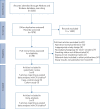Systematic review and meta-analysis of residential radon and lung cancer in never-smokers
- PMID: 33536262
- PMCID: PMC9488946
- DOI: 10.1183/16000617.0230-2020
Systematic review and meta-analysis of residential radon and lung cancer in never-smokers
Abstract
Background: Globally, radon is the leading risk factor for lung cancer in never-smokers (LCINS). In this study, we systematically reviewed and meta-analysed the evidence of the risk of LCINS associated with residential radon exposure.
Methods: Medline and Embase databases were searched using predefined inclusion and exclusion criteria to identify relevant studies published from 1 January 1990 to 5 March 2020 focused on never-smokers. We identified four pooled collaborative studies (incorporating data from 24 case-control studies), one case-control study and one cohort study for systematic review. Meta-analysis was performed on the results of the four pooled studies due to different measures of effect and outcome reported in the cohort study and insufficient information reported for the case-control study. In a post hoc analysis, the corresponding risk for ever-smokers was also examined.
Results: Risk estimates of lung cancer from residential radon exposure were pooled in the meta-analysis for 2341 never-smoker cases, 8967 never-smoker controls, 9937 ever-smoker cases and 12 463 ever-smoker controls. Adjusted excess relative risks (aERRs) per 100 Bq·m-3 of radon level were 0.15 (95% CI 0.06-0.25) for never-smokers and 0.09 (95% CI 0.03-0.16) for ever-smokers, and the difference between them was statistically insignificant (p=0.32). The aERR per 100 Bq·m-3was higher for men (0.46; 95% CI 0.15-0.76) than for women (0.09; 95% CI -0.02-0.20) among never-smokers (p=0.027).
Conclusion: This study provided quantified risk estimates for lung cancer from residential radon exposure among both never-smokers and ever-smokers. Among never-smokers in radon-prone areas, men were at higher risk of lung cancer than women.
Copyright ©ERS 2021.
Conflict of interest statement
Conflict of interest: E.S. Cheng has no conflicts of interest to declare. Conflict of interest: S. Egger has nothing to disclose. Conflict of interest: S. Hughes has nothing to disclose. Conflict of interest: M. Weber reports other support from Cancer Australia and Australian Department of Health, outside the submitted work. Conflict of interest: J. Steinberg has nothing to disclose. Conflict of interest: B. Rahman has nothing to disclose. Conflict of interest: H. Worth has nothing to disclose. Conflict of interest: A. Ruano-Ravina has nothing to disclose. Conflict of interest: P. Rawstorne has nothing to disclose. Conflict of interest: X.Q. Yu has nothing to disclose.
Figures



References
Publication types
MeSH terms
Substances
LinkOut - more resources
Full Text Sources
Other Literature Sources
Medical
